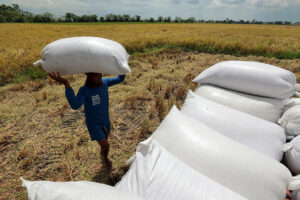Rice export curbs give farmers room to hike prices

By Sheldeen Joy Talavera, Reporter
RICE EXPORT curbs imposed by India and Vietnam will likely increase rice prices overall, with the higher cost of imports providing cover for sellers to charge more for domestically-grown rice, industry officials said.
“What happens within our market is (when the price of) imported rice goes up, domestic prices go along because imported rice is the competitor of domestic rice,” Raul Q. Montemayor, national manager of Federation of Free Farmers, told BusinessWorld by phone.
In May, Vietnam announced its plan to reduce rice exports to four million tons a year by 2023, Reuters reported.
“The government said that it will focus on the production of high-quality, fragrant and glutinous rice, while reducing the production of low-quality grains to 15% of total output by 2025 and to 10% by 2030,” it said.
In the six months to June, Vietnam was the Philippines’ top rice supplier, accounting for 1.61 million metric tons (MT) or 89.09% of the total.
It was followed by Myanmar and Thailand with 81,895 MT and 73,667 MT, respectively.
“India is planning something similar to control their inflation because rice prices there are going up in response to rising export prices. There will be a mad scramble for available stocks that will result in rising prices,” Mr. Montemayor said.
In a July 20 decision, India imposed an “immediate” ban on exports of non-basmati white rice to ensure domestic availability and curb the rise in prices.
The curbs were announced in a notification issued by the Directorate of Foreign Trade of the Department of Commerce, via the amendment of its export policy on the commodity from “Free” to “Prohibited.”
According to Fitch Solutions BMI on Friday, the export ban may have “substantial ramifications for trends in the global market.”
“As a result, the ban adds significant further upward price impetus to the global rice export market, average prices for which stood 13.9% higher in June 2023 than 12 months previously as per the (United Nations’ Food and Agriculture Organization) Rice Price Index,” it said.
Philippine rice imports from India hit 12,023.89 MT in the first six months, equivalent to 0.63% of all imports.
“We don’t buy much from India, but because India accounts for 40% of global rice exports, what is does will have spillover effects on other exporters like Vietnam,” Mr. Montemayor said.
He said that every P1-increase in the price per ton of Vietnamese rice translate into a P5 increase in the landed cost, including tariffs.
Ateneo de Manila economics professor Leonardo A. Lanzona said in a Facebook Messenger chat that the export curbs in our supplier countries will be inflationary.
“Imported rice prices were previously lower than the domestic price, so they contributed to lower inflation. With higher imported rice prices then, we would expect inflation to rise,” he said.
The Philippine Statistics Authority estimates based on preliminary data that consumer price index growth eased to 5.4% in June from 6.1% in May.
Food inflation decelerated for a fifth consecutive month to 6.7% in June.
Rizal Commercial Banking Corp. Chief Economist Michael L. Ricafort said the export curbs will reduce the global rice supply and could lead to an “uptick” in world prices, raising the Philippines’ rice import bill.
“This could lead to some uptick in overall inflation, or at least slower easing of the inflation/disinflation trend for the coming months since rice accounts for nearly 10% of the country’s (consumer price index) basket,” he said in a Viber message.
Mr. Lanzona said that the government should prepare for these developments and take them as an opportunity to boost domestic rice production.
“The years when the government simply allowed imports without enabling farmers to compete will take a major toll now in the form of higher rice prices,” he said.
“The government should turn problems into opportunities for greater efficiency and inclusivity, and not turn its back on issues by means of easy and palliative solutions. We need to go to the root of the problems,” he added.
Jayson H. Cainglet, executive director of Samahang Industriya ng Agrikultura, said in a Viber message that imports and reduced tariffs “have not tamed rice prices.”
“The most crucial is, for the country’s economic team to accept that they failed miserably in equating unlimited rice imports and lowering rice tariffs as our main solution to combat inflation,” he said.
Mr. Cainglet said that the last two crop seasons have been favorable to farmers due to interventions such as higher palay procurement from the private sector and increased fuel and fertilizer subsidies from the government.
“These developments are encouraging farmers to plant and more institutional support from the (Department of Agriculture) would further encourage the local rice industry,” he said.
Agriculture Undersecretary for Rice Industry Development Leocadio S. Sebastian said that the department’s plan is embodied in the five-year Masagana Rice Industry Development Program, with the aim of raising self-sufficiency.
“As of now, local production is augmented by imports. The plan is to gradually reduce imports as we ramp up production,” he told BusinessWorld in a Viber message.
Asked about the impact of export decisions from Vietnam and India, he said: “I don’t want to speculate. There are already many people speculating. I want to see the data first and see how the market is reacting.”
As of Friday, domestically-produced well-milled rice sold in Metro Manila for between P40 and P49, while regular-milled rice fetched between P36 and P44.
Imported well-milled rice sold for between P41 and P48. The Philippines does not import regular-milled rice.Meanwhile, Mr. Sebastian said in a statement that El Niño may actually increase yields amid fears on reduced supply due to potential crop losses.
“When the El Niño is preceded by normal to above-normal rain, this allows water reservoirs to stock enough water for irrigation. Sunny weather brings higher palay yields and better milling recovery from better quality palay harvest,” he said.
He asked officials in the field to maximize production in irrigated areas and diversify crops in areas expected to suffer from water deficits.




